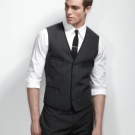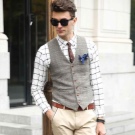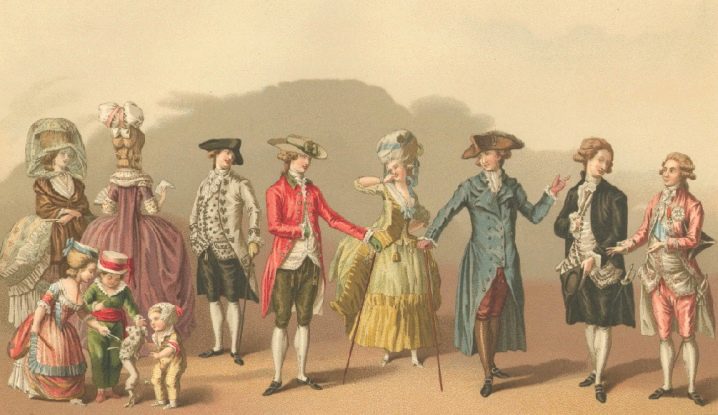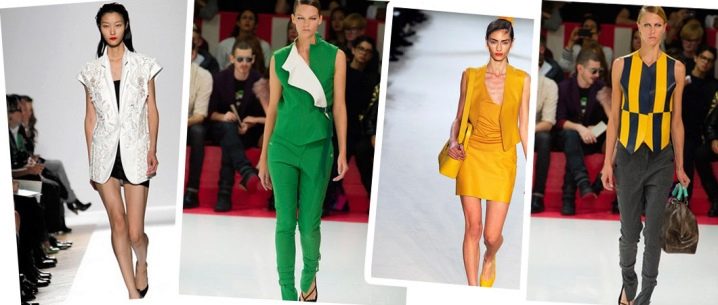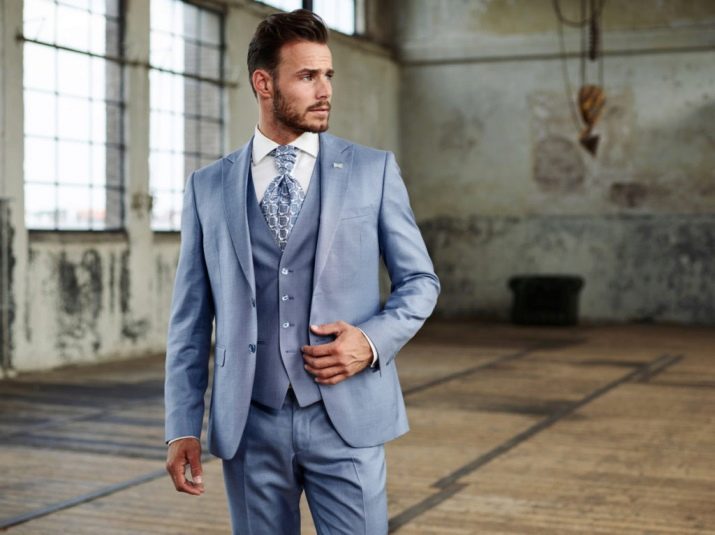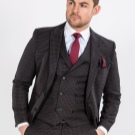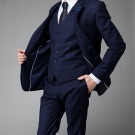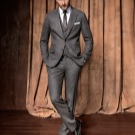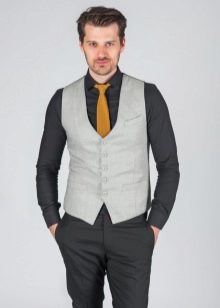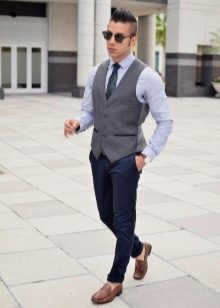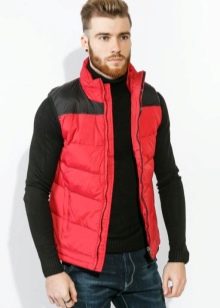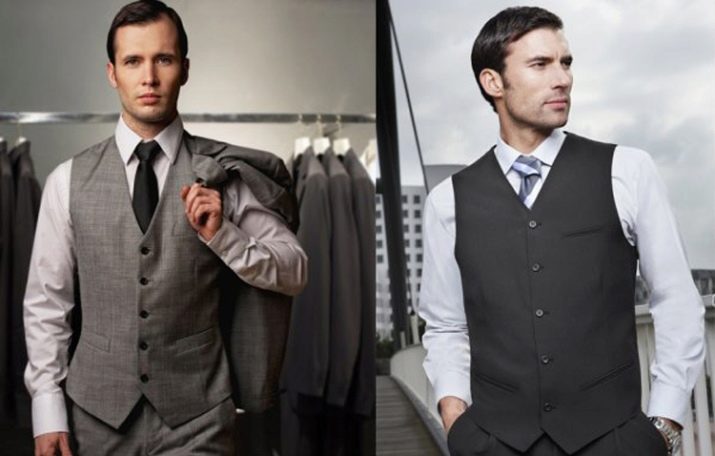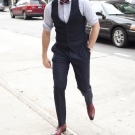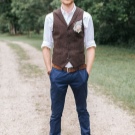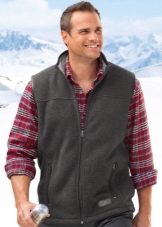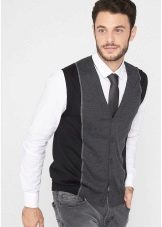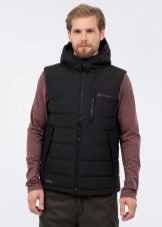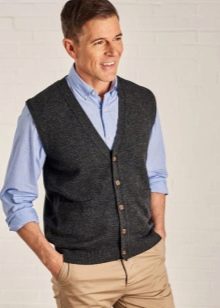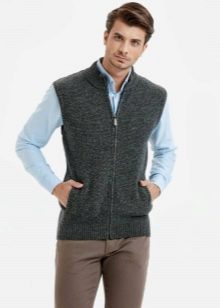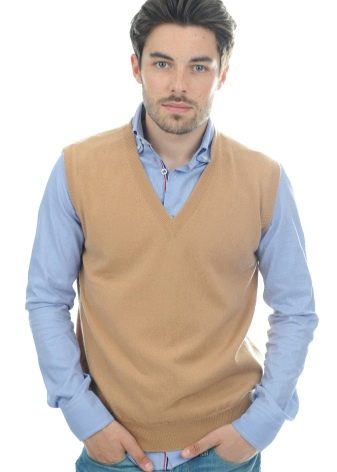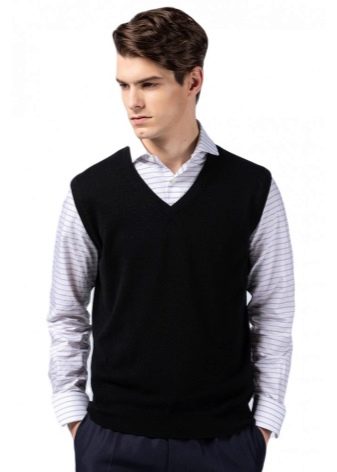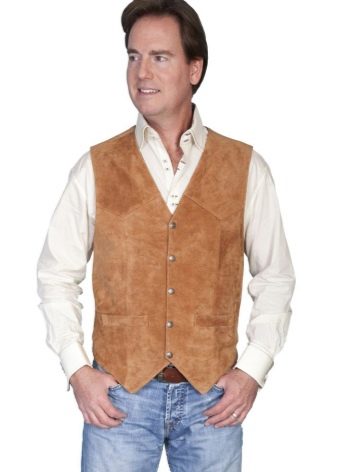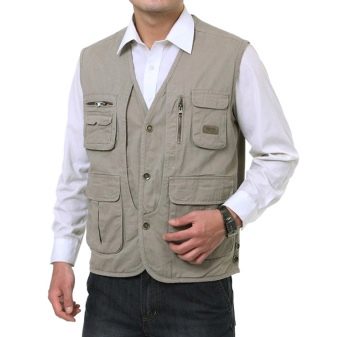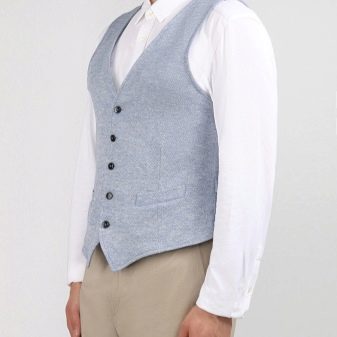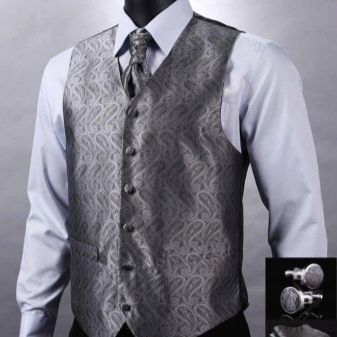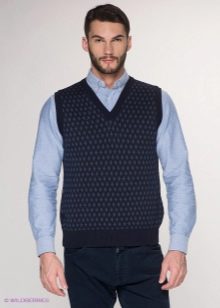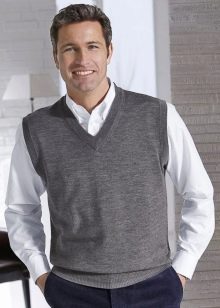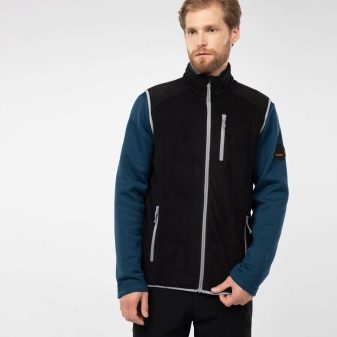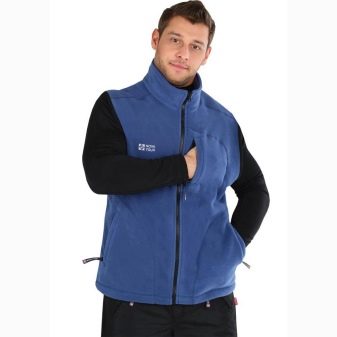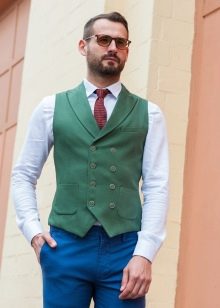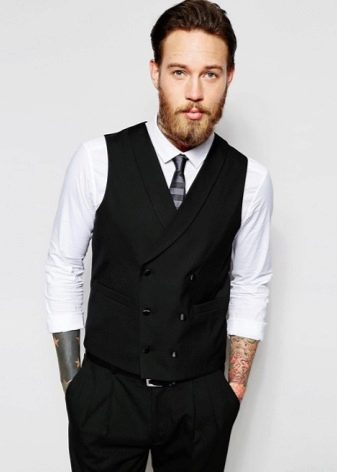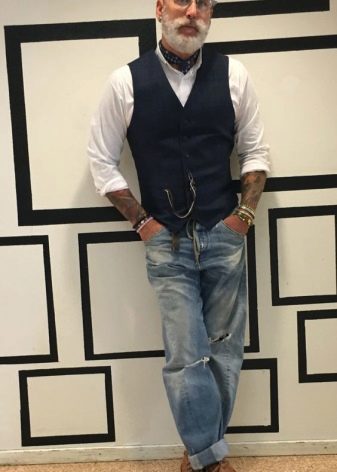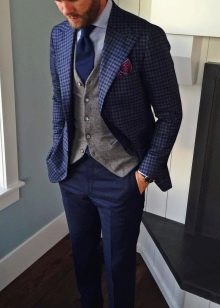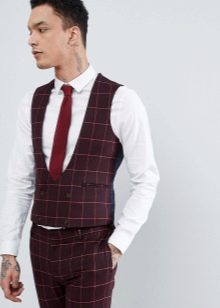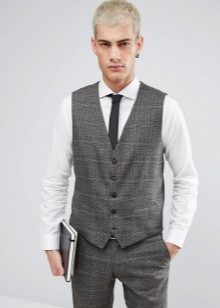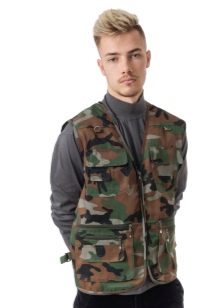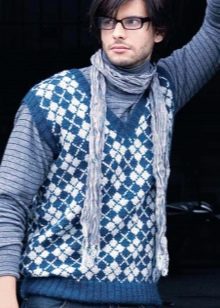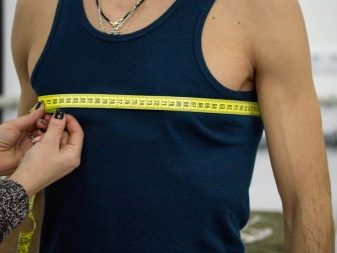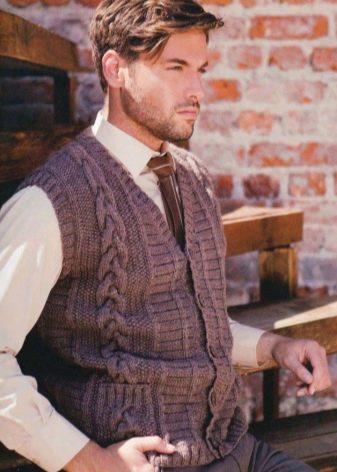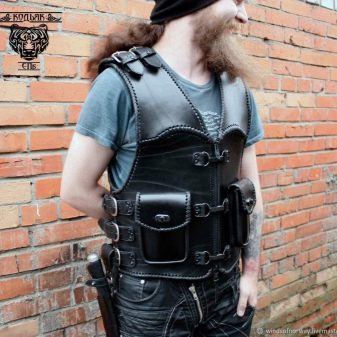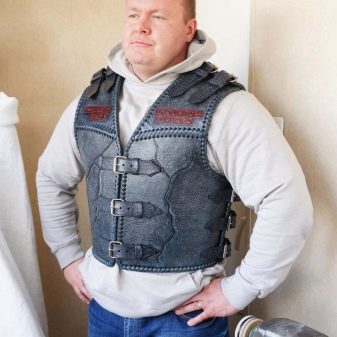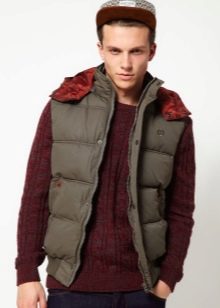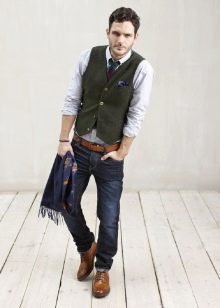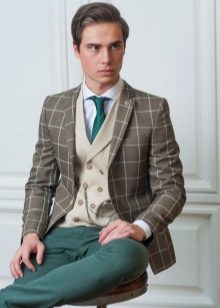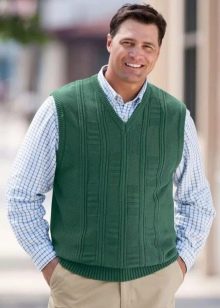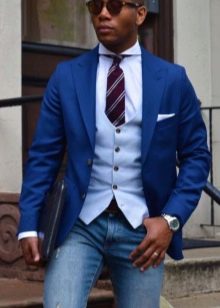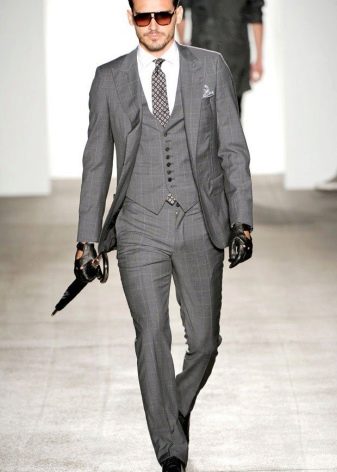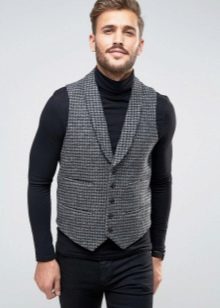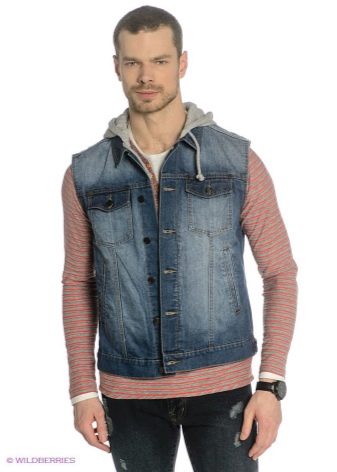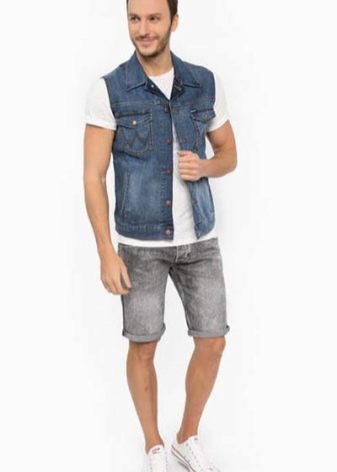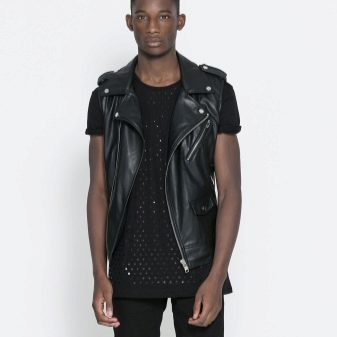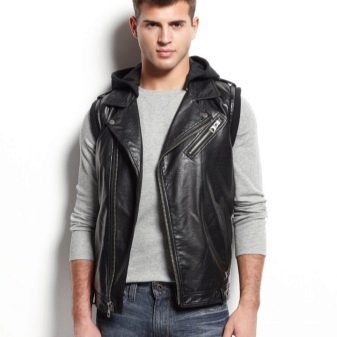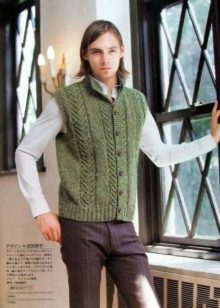Men's vests: varieties and tips for choosing

Gone are the days when vests were a useless piece of clothing. Today they are appreciated for their practicality, comfort and the ability to give the image a complete, stylish look. Now they are happily worn by men, women and children. Men's vests, on the one hand, have become integral elements of classic three-piece suits, and on the other, they are a fashionable and comfortable addition to a formalized dress code or everyday “casual” style.
Types and models
According to one of the most probable versions, the men's vest owes its origin to Turkey, where a sleeveless jacket called "jelly" was widespread... Gradually, as an item of men's wardrobe, "jelly" migrated to the Arab countries, and then to France and Spain. Outwardly, the predecessor of vests was significantly different from the current products - sometimes it had sleeves and elongated floors. In the 17th century, it was worn under casual wear or as a home option.
Closer to the 18th century, another analogue of a vest appeared - a camisole. The length of the camisole reached the knees. Models were sewn fitted, often without sleeves. At the end of the 18th century, camisoles, having lost their length, turned into vests, which, as they were transformed, gradually losing their main functions, became an accessory. Vests are sewn from expensive fabrics and are richly decorated. Popular models of that time from brocade, cashmere, velvet are decorated with buttons and precious items, emphasizing the high origin of the owner. In the course were models with a complicated cut, patterned (cage, strip).
In the 1820s, men, seeking to highlight their figure, resorted to wearing corsets, and vests were sewn tightly to the figure, highlighting the width of the shoulders and the waist. In Russia, vests appeared thanks to Emperor Paul I. Domestic "fashion designers" with their inherent creativity and imagination boldly made adjustments, changing the cut, length, shape of the neckline and other details of the models. The aristocracy of the products and their high cost remained unchanged. Therefore, some models were too chic and even pretentious, demonstrating a high level of wealth for the aristocracy. In the 19th century, vests also found their way into women's wardrobes. The fair sex began to wear them on top of other clothes. The cropped vest without buttons (model "bolero") was especially popular.
After a slight drop in demand for vests in the 20th century, when men preferred sweaters, and the weaker sex preferred tight-fitting suits and skirts, in the 60s, vests regained their former popularity... This was due to the boom in the development of various kinds of informal movements. Knitted and factory models, decorated with flowers or various folklore motives, entered into youth use. Products made of denim or leather, with rivets and patches have gained particular popularity among bikers. A little later, vests became a kind of symbol among fans of indie culture and steampunk trends.
As an element of women's clothing, vests began to symbolize independence, determination, the struggle for equality and feminism. Wide-cut vests with "shoulder pads" that gave women a touch of courageous determination were popular models of the 90s. Trouser sets and three-piece suits with vests turned out to be in vogue. In the future, things from knitwear and knitted products became widespread. A separate line is the use of vests as an element of workwear and professional uniforms.In the 2000s, vests become indispensable objects of shows with the participation of famous fashion models, they are also distributed in everyday life.
Vests are characterized by extraordinary versatility and functionality - they are practical and comfortable, being used both for keeping warm and as a stylish accent of the image. The vest overcame the narrow boundaries of the classics and turned into an independent and fashionable piece of clothing.
Fashionable models of vests today amaze with their diversity: sports, warm, image, vests-coats, vests-jackets, quilted and puffy, down-padded vests.
Nevertheless, with all the variety of models, there are definitely three main directions for using vests.
- Formal Male Black Tie Variations not used without jackets. Some are made without a back. Often this type of vest is sewn with lapels, which distinguishes them from many other vests. They are usually performed with a shortened front side. This allows the white shirt to be more exposed. They are usually made from the same fabric as tuxedos.
However, this rule is not binding, since bright, tasteful colors carry elements of novelty.
- Classic costume models. By the beginning of the 20th century, a three-piece suit was the standard, but in the 40s it began to go out of fashion, as it became necessary to save expensive fabrics. Nowadays, the "three" is relevant and remains the height of elegance and classicism, like double-breasted jackets. Experienced craftsmen are involved in sewing such models, since the quality of sewing is an important factor in this style. Suit vests should fit snugly around the waist and sit slightly higher than the jacket lapels, expanding to a certain extent and covering the client's shoulders. Such options are sewn without collars. As in the first case, "threes" can include vests from a fabric similar to the suit or sewn from other fabrics.
The latter option allows you to get away from excessive formalism in the image for a light evening banquet, but is unacceptable for official meetings. For an informal setting, oriental monograms and herringbone patterns are quite suitable.
- Men's vests as separate items of clothing harmoniously fit into the business-casual style, being an addition to the color scheme of shirts and trousers. The color of the vest here is usually different from the trouser one. The style is more relaxed than the classic version. The selection of color is not strict, it is enough to have dark trousers and any light shirt, and the addition of bright shades of the vest will not bring dissonance to the image.
Stripes, a cage or bright Arabic patterns will be quite acceptable here. A bow tie or a simple thin tie tucked under the vest is appropriate within this style.
Casual (casual) vests or sleeveless jackets can be used as outer or underwear (T-shirts, sleeveless vests, etc.) Vests for the weaker sex are often used as an accessory. The short, tight-fitting vest perfectly highlights the silhouette and raises the chest. Long forms an elegant image, helps to hide minor flaws in the figure.
Men's options fit easily into business dress codes. This is a kind of "golden mean" that separates the strict and informal notes of the image.
In fact, vests are a great option within a business-casual style suitable for celebrations, weddings or parties.
Materials (edit)
A wide variety of materials and their combinations are used for the manufacture of vests. Leather, satin, corduroy, woolen, cotton, fleece or fur products are extremely fashionable today. At the same time, craftsmen realize their irrepressible imagination when decorating products: pockets, embroideries, paintings. Young people prefer jerseys made in a sporty style, comfortable for walking and friendly meetings.Winter, insulated versions of vests are also popular now.
Vests from other fashionable materials.
- Woolen vests it is recommended to select from a dense texture, since thin material will soon lose its presentation. Thick fabric lasts longer.
- Cashmere products look great and solid and allow you to create elegant bows that are appropriate for office events.
- Suede vests They are extremely comfortable and versatile, but they are expensive and require careful maintenance.
- Leather vests they look great and allow you to form original bows, which, however, do not quite fit into business situations. They look rather informal.
- Cotton products - a great solution for the warm season, but the material wrinkles a lot.
- Silk vests look extremely fashionable and are used mainly for special occasions.
If the shine of silk turns out to be too pretentious and confuses you, then a model that combines wool and silk will be appropriate. This mixture gives a matte finish.
- Knitwear versatile and fit perfectly into business and everyday surroundings. Their characteristic feature is their extraordinary softness.
- Knitted patterns available in wool and polyester. Here, the quality of knitting is of decisive importance, which, for example, can be shawl, openwork and other types. Notch shapes can be round or triangular. Vests with collars have an excellent look.
- Denim - stylish and bright wardrobe items that allow you to form unexpectedly original images within the "casual" style. The material is interesting for adherents of newfangled subcultures seeking to emphasize their individuality. Denim vests are produced with or without hoods, with pockets, in warmed versions.
With any model, you can create an original image for any situation.
- Fleece material looks great in sleeveless jackets for a family vacation or a friendly picnic.
The sportiness of these things is a characteristic stylistic load, a hint of comfort and practicality.
Colors
The color schemes of the vests are extremely diverse: brown, green, black, red, gray, white, blue, beige, khaki and other shades of products fit well into various sets and situations. Traditional style vests are usually made in a neutral color palette and are ideal for shaping a business look. For a more informal style, you should choose vests in light or bright colors.
Let's stop here on the main color palette of vests.
- Black - a standard color scheme that easily complements any look. These vests look great when paired with dress pants or trendy jeans.
Such options look advantageous and slim the figure.
- Blue - goes well with other colors and looks less formal. Blue vests can be easily combined with a variety of clothing options, contributing to the creation of casual casual compositions.
- Gray - democratic and at the same time strict color scheme. Perfect for creating a business style.
In this context, the charcoal shade is especially good, which never goes out of fashion trends.
Patterns and prints
The patterns and prints of the vests are as varied as their colors. Plaid vests gravitate towards classics, but the range of their fashionable applicability is wider than that of typical classic models, since the check enlivens the image and does not look as boring as monochromatic products. Nevertheless, they perfectly complement the business trend in fashion. It's all about choosing a neutral color palette.
Camouflage vests of various shades are now popular. The options for their applicability as an informal element of clothing are extremely wide, especially among young people.The richness of patterns and versatility of use are demonstrated by knits that fit the formal style. Solid colors with a slightly muted pattern look great with ties and a shirt.
Dimensions (edit)
The dimensions of the vests are determined by the girth of the chest and the height of the torso from shoulder to waist.
Measurement procedure:
- for the accuracy of measurements, they must be carried out with the participation of an assistant, since independent measurements give an error of up to 5 cm, that is, they will not provide the necessary accuracy;
- correct measurements are made exclusively with a standard tailor tape;
- measurements of the height of the product are carried out on both sides of the body located on a flat surface, focusing on the value of the larger parameter;
- measurements are carried out in underwear.
How to choose?
The image should be matched with a specific event, and then with the weather, the season. Vests, despite their versatility, must be chosen thoughtfully and correctly, including them in the overall image.
- Business, formal meetings involve classic and knitted vests that emphasize business notes and highlight the individual features of the wearer.
- Rock concerts, biker shows, parties - situations in which you can try brutal images. In other cases, brutal clothes can shock the environment with their shocking.
- For walks, outdoor activities or as an everyday option, inflated versions of sports vests are great.
- The casual style is universal where a special dress code is not required. Walks, dates, business visits, formal and not-so-formal events are quite suitable occasions when casual vests will be appropriate.
When choosing a vest as an independent item of clothing, you must take into account a number of recommendations.
- The fabric of the product must match the materials of the rest of the garments, allowing the selection of close options.
- In a set with trousers and jackets, the compatibility of shades is important.
- The choice of a particular product for a man directly depends on his height, weight and constitution. For obese men - one thing, for thin men - another, taking into account individual styles and specific situations.
What to wear with?
The simplest variation is a vest under a jacket. Pants should be made of a similar material, and all elements of the composition should be in harmony in color. In the classic style, the products are combined with a shirt, buttoned collar. Accessories - bow tie, tie. Vests are perfect for trousers and classic business-style shoes. In combination with skinny trousers, a white shirt and stylish loafers, they look fresh and stylish.
Elegance and classic style are achieved by the fact that all the elements of the set are made of real fabrics in soothing shades.
Some recommendations:
- the three-piece suit is suitable exclusively for classic models of shoes;
- the bottom buttons on classic vests are kept unbuttoned;
- tweed and corduroy vests are usually used in cooler seasons and can be complemented with a turn-down collar;
- A handkerchief is added to the chest pocket for a solid color, classic style vest.
Vests with jeans form an informal image that can be used every day. Complemented with rolled-up sleeves.
Denim vests are worn:
- with a T-shirt, denim shorts and sports shoes in the warm season;
- with jeans of other shades, jumpers, sweaters on cooler days;
- with shoes for the season (loafers, moccasins, boots).
Puffy vests are usually used as an element of outerwear during the off-season. They are more comfortable than jackets and shape the sporty direction of the style. For their sewing, synthetics and natural fabrics are used, and down, synthetic winterizer and other insulation can be used as a filler. They should be worn with jeans, cotton trousers, sports shoes or boots. Sweatpants, coarse sweaters, flannel shirts, pullovers, etc. will do.
We do not recommend wearing:
- knitted products with animal ornaments or other cute prints, it looks sugary and tasteless;
- knitted or crocheted items with shirts of the same tone, this combination "erases" the image;
- excessively shortened or elongated vests distort the silhouette lines and form an unpleasant perception;
- products with many patch pockets, nets and other elements, with the exception of uniforms;
- leather vests with loose trousers and a light shirt.
Stylish looks
The desire of designers to create a fashionable look does not stand still. One of the novelties is knitted wrap vests for casual city lovers. Wide trousers, together with massive shoes, a thin T-shirt and a vest, form an interesting, eye-catching fashionable bow.
A vest that looks like a leather jacket will help to form a brutal-romantic image, which will perfectly combine with jeans or narrow, "classic" trousers, fashionable shoes, T-shirts, sweatshirts and rough sweaters.
Knitted vests of various knitting methods with beautiful patterns have become a progressive trend. They weaken the "line of austerity" in the style, softening the formal component of the image. More laconic knitted vests enhance the business line of the image. Plain shirts or trousers with classic shoes are suitable here.

